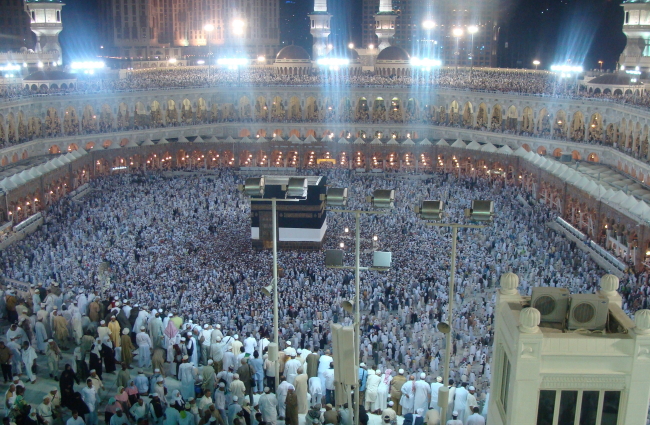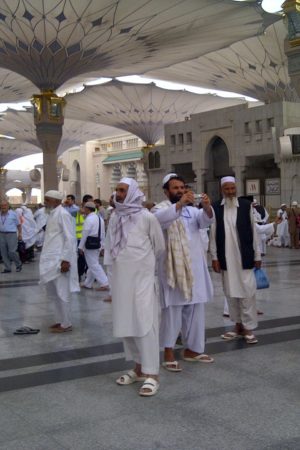FRIDAY, AUGUST 9: Millions of Muslim pilgrims—including 20,000 Americans—have been pouring into Mecca from across the globe, preparing for a journey most have anticipated their entire lives: Today begins the annual pilgrimage that is Hajj.
To complete one of the five pillars of Islam, Muslims must visit Mecca and fulfill the Hajj rituals that reenact the actions of the Prophet Muhammad in his “farewell pilgrimage,” in 632 AD.
Arriving via every mode of transportation available and from countries that span the globe, this annual Islamic pilgrimage is widely considered the largest annual gathering in the world.
NEWS UPDATES: Soaring temperatures are expected during this year’s Hajj, as experts estimate mid-August temperatures to reach 50 degrees Celsius (122 degrees Fahrenheit), with humidity getting up to 85% (Arab News reported).
As more than 2 million Muslims from upward of 160 countries visit Mecca for Hajj—and with numbers expected to continue to rise each year—the Saudi Arabian government is continually looking for new ways to better maintain safety and comfort for its annual flood of pilgrims. Its goal? The ability to host 30 million pilgrims annually by the year 2030. (Currently, numbers are restricted; read more at Fortune.com.)
In efforts to increase safety, security and comfort through technology, Saudi Arabia hosted its first “Hajj Hackathon” last year, as coders and entrepreneurs competed over a period of 36 hours in building applicable apps and services (Fortune has the story). The winning team designed a smartphone app to help non-Arabic speakers translate signage without an Internet connection, but the Ministry of Hajj and Umrah is also piloting, this year, a smart-card initiative that is expected to assist in predicting crowd movements and heading off stampedes and crushes.
PILGRIMAGE TO MECCA: AN ANCIENT JOURNEY
The Hajj pilgrimage is regarded as a religious duty that must be undertaken by every adult Muslim at least once in his or her lifetime—if that person has the mental, physical and financial ability to make the long journey. Despite the word “duty,” Muslims regard Hajj as an experience to be treasured. The ritual of a pilgrimage to Mecca actually stretches back centuries before the advent of Islam—to the time of Ibrahim (Abraham)—yet it was the Islamic prophet Muhammad who cemented the rituals of Hajj in the seventh century. The uniform method of performing the rituals of Hajj is meant to demonstrate both the solidarity of the Muslim people and their submission to Allah (God).
Did you know? Before the construction of the abundance of hotels in today’s Mecca, citizens of the city often opened their homes to pilgrims. In this article from The National, a Muslim woman recalls her childhood spent as a resident of Mecca—and the importance of seeing a variety of pilgrims staying in her grandparents’ home.
AMERICANS AND THE HAJJ
The U.S. Consulate General in Jeddah, Saudi Arabia, has published a helpful brochure for American pilgrims, including these facts:
- In 2018, approximately 20,000 Americans performed Hajj, of approximately 2.3 million pilgrims total.
- The Hajj terminal in Jeddah, completed in 1982, was designed by an American Muslim, Fazlur Rahman Khan, whose designs include Chicago landmarks the Hancock and Willis (Sears) Towers.
- Approximately 50 Hajj tour providers have offices in the United States and facilitate the participation of Americans in Hajj every year.
THE ORIGINS OF HAJJ: ABRAHAM, HAGAR & ISHMAEL
Islamic tradition tells that in approximately 2000 BCE, Abraham was ordered by God to leave his wife, Hagar, and his son, Ishmael, in the desert of Mecca while he traveled to Canaan. After Abraham left, food and water quickly ran out; Hagar ran back and forth between the hills of Safa and Marwa seven times. Exhausted, Hagar laid Ishmael on the sand and begged God for help. Miraculously, a well sprang up at the baby’s feet, and that well—the Zamzam Well—continues to provide ample water to Hajj pilgrims today. Later, according to Muslim tradition, Abraham was commanded to build the Kaaba, so that people could perform pilgrimage there. It is believed that the Archangel Gabriel brought the Black Stone from heaven to be attached to the Kaaba, and today, the Black Stone marks the beginning and ending point of each circle a pilgrim makes as he circulates the Kaaba during Hajj.
Should politics play a role in the decision to travel to Mecca for Hajj? The Pittsburgh Post-Gazette reports both sides of the story.
Jahiliyyah: During a time known as jahiliyyah in pre-Islamic Arabia, the Kaaba had become surrounded by pagan idols. To cleanse the Kaaba, the Prophet Muhammad led his followers from Medina to Mecca in what is now regarded as the first Hajj. The pagan idols were destroyed, and Muhammad rededicated the Kaaba to God. At this point, Hajj became one of the five pillars of Islam, and adherents have been making the journey ever since.
PILGRIMAGE RITUALS:
THE GRAND MOSQUE, MOUNT ARAFAT AND THE ZAMZAM WELL
Before the start of Hajj, pilgrims bathe, don special clothing and make a statement of intent at the entry station. The first ritual of Hajj is performed inside the Grand Mosque complex: pilgrims circle the Kaaba structure seven times, counterclockwise, reciting prayers (tawaf). Following tawaf, many drink from the Zamzam well. Next, Muslim pilgrims walk rapidly between the hills of Sara and Marwa seven times, as Hagar did (al-Sai). Another statement of intent is made, after which the faithful travel through Mina, and on to the plains of Mount Arafat.
Intense prayer for forgiveness is offered at Arafat, as Muhammad said, “Far more people are freed from the Hellfire on the Day of Arafat than on any other day.” This portion of the Hajj journey is one of the most important. Small stones are gathered, and the following day, pilgrims perform a symbolic “stoning of the devil” at Mina (rami).
Enjoy Video Clips Courtesy of The National
The National, the daily English-language newspaper based in Abu Dhabi, is providing a number of helpful videos for pilgrims this year. These videos will play full screen, if you wish. Use the “Esc” key when you’re done.
Here is the National’s basic video explaining the Hajj.
Here are a series of practical tips for what to wear—and how to pack—for the Hajj. (Note: This video’s default settings may require you to turn on the audio by clicking in the lower left corner of the video screen.)

